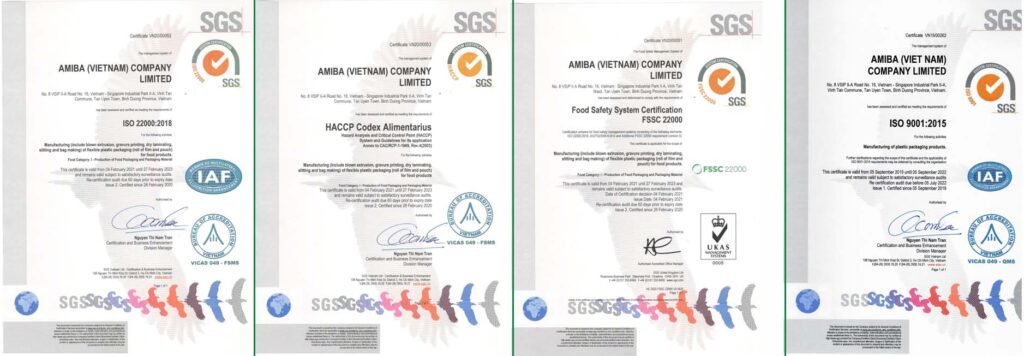Laminated film packaging has been widely used in many manufacturing industries such as food, beverages, cosmetics, pharmaceuticals, etc., thanks to its outstanding advantages. So how is laminated film packaging produced? Let’s take a look at Amiba’s laminated film packaging production process.
1. Design
The Heidelberg Primescan D7100 tube scanner is used to convert the simulated image into a digital image while completing the adjustment and color separation of the screen. This ensures consistent color quality when printing later.

2. Blown Film
Multi-layer blown film LLDPE, HDPE, and water-quenched PP blown film with width range from 20 cm to 2.8 meters. Machinery is equipped with automatic gauge air-ring control to increase productivity by 40% and ensure bubble stability.
In this process, the films are fused together to form a 3-layer laminate. Extruded polyethylene is passed between the layers to bind the two layers, which are then fused together. The layers laminate thus obtained is then bound with the inner layer (food grade film) resulting in a 3-layered laminate. The film, nylon, and foil laminates are produced by extrusion lamination. Mono and multilayer PE films, nylon barriers, and aluminum foil form the basic structure of the laminated film.
One of the most common methods of film manufacture is Blown Film (also referred to as the Tubular Film) Extrusion. The process involves the extrusion of a plastic through a circular die, followed by a “bubble-like” expansion. Blown Film Extrusion can be used for the manufacture of co-extruded, multi-layer films for high barrier applications such as food packaging.

3. Printing
Amiba uses one 9-colors (with matte ink) and one 10-colors gravure printing machine with a speed of 300m/min. The maximum width of web roll is 1300mm.
Once the laminate is slit to the desired size it is ready for printing. Artworks provided by customers are processed using sophisticated technology to enable accuracy with the printing of colors and other details on the laminate. There are 6 to 10 inking stations for different colors. When the printing process is completed, different colors are merged together to give the desired design.
A wide range of printing processes is used in the plastic film industry according to the desired finished effect. Inks and solvents can also be specified according to the needs of the end customer and to the nature of the packaging being produced.

4. Inspection
Visual Inspection system effectively reduces the rejection rate of printed products, improve product quality, prevent non-conformed products from flowing into end-users
This step will help to add perfection to your packaging and also show the professionalism of Amiba packaging.
5. Dry lamination and solventless lamination
Various materials are laminated together to meet the packaging requirement of customers. We adopt solvent dry lamination and solventless lamination techniques. Laminated rolls are cured for a period of time before going to the next production step.

Laminating is a bonding process for two or more layers that can confer vital properties to plastic multi-layer films including special barriers, coatings, tear-resistance, and protection for other layers in the film structure. Films can be laminated as part of the industrial film conversion process using one of a number of techniques according to the nature of the materials and the desired properties. Processes include fusing using heat and pressure, wet adhesives, or heat reactivation layers.
The development of laminated films has made significant improvements to film performance particularly in food packaging where food preservation can be greatly enhanced as can the shelf appeal of products.

6. Sliting
Laminated film is slitted into small roll according to customers’ request. Amiba is equipped with machinery speed 500metres/min to ensure the stability of the automatic packaging line

The reel laminates are placed in the intermediate store for curing. Once the curing process is completed, the laminates are taken to the slitting machine. The reels of laminates are unwound here to be slit into various sizes based on the size of the design, to match customer specifications. Amiba makes use of high-speed rotary slitters, which minimize damages to the edges and ensures a precise printing process.

7. Bag making
We make high-quality pouches in various shape which can be applied in various fields. We produce from simple bottom-sealed, side-sealed to the stand-up pouch with zip.
8. Why is Amiba company always the first choice?
- More than 30 years of experience in the plastic and complex film packaging industry
- Provide products with high quality
- Large production capacity
- Cost savings
- Large warehouse system, fast delivery
- Diverse payment policy
- Being a close partner of many large companies and large enterprises
- Staff dedicated to the job
- The production environment is safe for humans and the environment
Amiba company’s products are widely used by ensuring quality management, environmental protection, and integrated ISO standards:
– It has been assessed and certified to meet the requirements of Hazard Analysis and Critical Control Point (HACCP) Codex Alimentarius
– It has been assessed and certified to meet the requirements of Food Safety System Certification (FSSC) 22000
– It has been assessed and certified to meet the requirements of ISO 22000: 2018
– It has been assessed and certified to meet the requirements of ISO 9001: 2015
If you need to learn more about laminated film packaging, or need advice regarding placing an order or getting a price quotation, please call now +84 966 290 555 for the best support.
CONTACT US
Address: Lot 8, Street Number 16, Viet Nam-Singapore II-A Industrial Park, Tan Uyen Town, Binh Duong Province, Viet Nam.
Office Tower: 25 Ngo Quyen Street, Ward 10, District 5, Ho Chi Minh City
Tel: +84 966 290 555
Email: info@amibapack.com
Website: www.amibapack.com

 Tiếng Việt
Tiếng Việt 中文 (中国)
中文 (中国)


